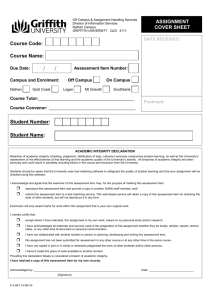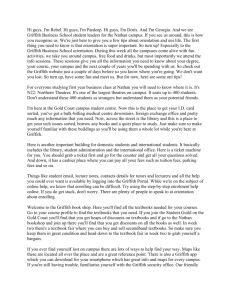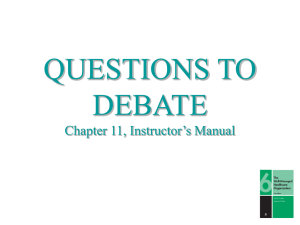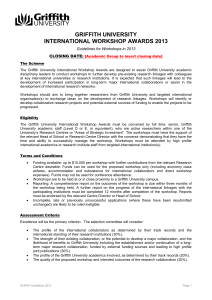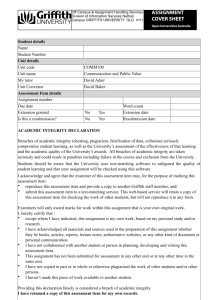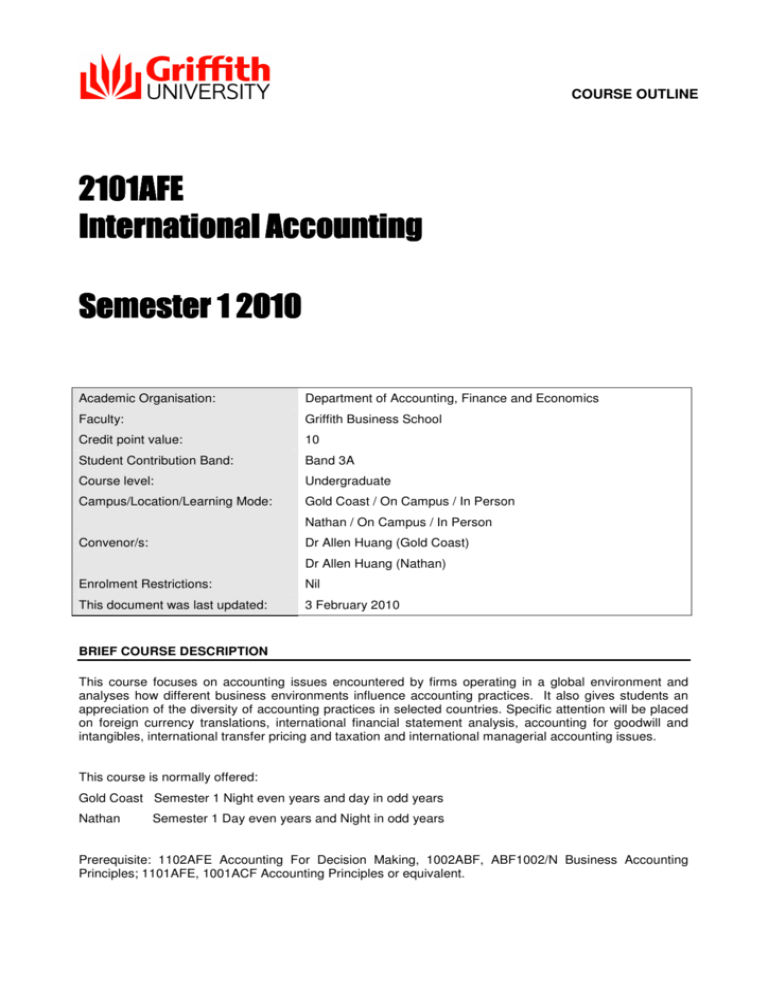
COURSE OUTLINE
Academic Organisation:
Department of Accounting, Finance and Economics
Faculty:
Griffith Business School
Credit point value:
10
Student Contribution Band:
Band 3A
Course level:
Undergraduate
Campus/Location/Learning Mode:
Gold Coast / On Campus / In Person
Nathan / On Campus / In Person
Convenor/s:
Dr Allen Huang (Gold Coast)
Dr Allen Huang (Nathan)
Enrolment Restrictions:
Nil
This document was last updated:
3 February 2010
BRIEF COURSE DESCRIPTION
This course focuses on accounting issues encountered by firms operating in a global environment and
analyses how different business environments influence accounting practices. It also gives students an
appreciation of the diversity of accounting practices in selected countries. Specific attention will be placed
on foreign currency translations, international financial statement analysis, accounting for goodwill and
intangibles, international transfer pricing and taxation and international managerial accounting issues.
This course is normally offered:
Gold Coast Semester 1 Night even years and day in odd years
Nathan
Semester 1 Day even years and Night in odd years
Prerequisite: 1102AFE Accounting For Decision Making, 1002ABF, ABF1002/N Business Accounting
Principles; 1101AFE, 1001ACF Accounting Principles or equivalent.
Incompatible: 2001ABF International Accounting;
2001ACF International Accounting; AB12003
International Accounting; ABF2001 International Accounting.
SECTION A – TEACHING, LEARNING AND ASSESSMENT
COURSE AIMS
This course is designed to prepare students to contribute professionally and operate effectively in a global
business environment. It aims to assist students in their understanding of how differences and changes in
business environments affect the way accounting is practised and how to deal with specific accounting
issues brought about by international business transactions.
This course is a core course in the accounting area of the Bachelor of International Business Program. It
builds on Accounting for Decision Making and exposes students to the diversity of accounting practices
around the world. The accounting diversity is a result of the differences in the business environments and
practices in different countries, which are covered in other courses in the program.
The course focuses on accounting issues that are faced by business organisations operating in a global
environment and analyses how different business environments influence accounting. It also gives
students an appreciation of the diversity of accounting standards and practices in selected countries.
Specific attention will be placed on topics such as, Accounting for Foreign Currency Transactions and
Translation of Foreign Currency Financial Statements, International Financial Statement Analysis,
International Harmonisation of Accounting Standards and Practices, International Transfer Pricing and
Taxation, Foreign Exchange Risk Management, and international managerial accounting issues.
LEARNING OUTCOMES
Upon successful completion of this course, students will possess skills to analyse how and why accounting
is practised differently in different business environments and deal with specific accounting issues
encountered by business and other organisations in a global environment. This course will enhance
students' confidence and enable students to contribute professionally and operate effectively in
international business. More specifically, upon completion of this course students will be able to
1. Identify the relevant accounting issues confronted by business organisations that operate in the
international arena;
2. Detect the differences which exist in accounting standards and practices internationally and
understand the problems that are caused by accounting diversity;
3. Explain the reasons for accounting diversity and develop the links between accounting and the
environment in which it operates;
4. Explain how fluctuations in exchange rates lead to various problems in accounting and give rise to
foreign exchange risk;
5. Demonstrate the various accounting techniques that are used to account for foreign currency
transactions and translation of foreign currency financial statements and to manage foreign
exchange risk exposures;
6. Understand the efforts towards, the achievements of and obstacles for international accounting
harmonisation and predict the future direction of international harmonisation movement;
7. Understand the potential problems in using financial statements of foreign companies and apply
the techniques available to overcome the problems;
8. Describe differences in corporate income tax and withholding tax regimes across countries and
understand how transfer pricing systems, in conjunction with taxation systems, can be used to
achieve the corporate global objectives of multinational enterprises.
1
CONTENT, ORGANISATION AND TEACHING STRATEGIES
There will be 3 contact hours per week, comprising a 2 hour lecture and one hour tutorial as shown below.
Teaching Forum
Hours per Week
Weeks
Lecture
2
1 – 4, 6 – 13
Tutorial
1
2 – 4, 6 – 13
The lectures are designed to present systematically the principles and concepts, and highlight the
important areas on each topic. Tutorials will provide students with an opportunity to further consider the
application of concepts and principles through discussion and practical applications.
Students are expected to complete the weekly tutorial assignments before each tutorial and be prepared to
present and discuss them during the tutorial.
CAMPUS-SPECIFIC ARRANGEMENTS: This course is taught on two campuses this semester (Gold
Coast and Nathan). You are required to enrol and participate at one campus ONLY. All concerns will be
dealt with on a local campus basis. Throughout this Course Outline there will be campus specific
information – please make sure that you refer to the information that is RELEVANT TO THE CAMPUS
WHERE YOU ARE ENROLLED.
CONTENT SUMMARY
The content of the course builds from a theoretical background and introduction to the practical application
of accounting techniques. It establishes the causes of accounting diversity worldwide and then examines
specific accounting issues pertinent to business practices in a global environment. The sequence allows
students to enhance their knowledge and understanding of international accounting issues. (Please refer
to the Schedule of Lectures and Tutorials for detailed content.)
Topic
Lecture Content
Readings
1.
Introduction to International Accounting
Doupnik and Perera, Chapter 1
2.
Worldwide Accounting Diversity and
Reasons for Accounting Diversity
Doupnik and Perera, Chapter 2
3.
Comparative Accounting
Doupnik and Perera, Chapter 5
4.
International Monetary Systems and
Exchange Rates
Doupnik and Perera, Chapter 6
5.
Accounting for Foreign Currency
Transactions – I
Evans, Taylor and Rolfe, Chapter 6
Doupnik and Perera, Chapter 6
Deegan, Chapter 2
6.
Accounting for Foreign Currency
Transactions – II
Doupnik and Perera, Chapter 6
7.
Translation of Foreign Currency Financial
Statements
Doupnik and Perera, Chapter 7
8.
Analysis of Foreign Financial Statements
Doupnik and Perera, Chapter 9
Radebaugh, Gray and Black, Chapter 5
9.
International Harmonisation of Financial
Reporting
Doupnik and Perera, Chapter 3
10.
Foreign Exchange Risk Management
Evans, Taylor and Rolfe, Chapter 10
11.
International Taxation and Transfer Pricing
Doupnik and Perera, Chapters 10 & 11
12.
Summary and Revision
2
ASSESSMENT
Summary of Assessment
Item
Assessment Task
Length
Weighting
1
Mid Semester Exam
1 hour
20%
2
Group Assignment
2,000
3
Final Examination
2.5
hours
4
Tutorial Participation*
Total
Marks
Relevant
Learning
Outcomes
Due Day and
Time
20
1 – 5.
Saturday of Week
9, 8 May 2010
25%
25
1, 2, 3, 6, 7.
Monday of Week
11, 4:00pm
50%
100
1–8
Week 15 or 16
5%
5
1–8
Weekly
* This assessment item is used for the Amber Risk Assessment Task.
Assessment Details
Mid Semester Exam:
The mid semester examination is made up of multiple choice questions which are designed to assess
students’ understanding of the conceptual, theoretical and practical issues covered in the first six topics
of the course. This is a closed book examination.
Group Assignment:
The group assignment is designed for students to better comprehend the diversity of accounting systems
and practices worldwide and understand how different business environments influence accounting.
Students will be required to identify the key environmental factors in selected countries and analyse how
those factors have shaped and influenced the accounting systems and practices in the selected countries.
(The topics and requirements for the group assignment will be posted on Learning@Griffith in Week 3.)
Final Examination:
The final examination is to assess students’ overall understanding and level of attainment of the course in
a closed book and timed examination environment. The exam will comprise both theory and practical
questions. Material (specified as required readings in the Schedule of Lectures and Tutorials) covered in
the entire semester is examinable.
Students are required to submit all assessment items to qualify for a passing grade.
Return of Assessment Items
Results of the mid semester exam and group assignment will be posted on the Learning@Griffith website
when they become available and the hard copies of the assignments will be returned to students in the
tutorials.
Notification of Availability of Feedback on Assessment
The results of the mid semester exam will be published on Learning@Griffith for students to view and the
feedback on the overall performance on the exam will be discussed in Week 10 during the lecture. While
the written feedback on the assignment will be provided to each assignment the feedback on the overall
performance will be provided during the lecture in Week 13.
3
GRADUATE SKILLS
Assessed
Taught
Graduate Skills
Practised
Students can expect to learn the following skills as indicated in the ticked boxed below.
Effective communication (written)
Effective communication (oral)
Effective communication (interpersonal)
Information literacy
Problem solving
Critical evaluation
Work autonomously
Work in teams
Creativity and innovation
Ethical behaviour in social / professional / work environments
Responsible, effective citizenship
TEACHING TEAM
Course Convenor
Convenor Details
Gold Coast and Nathan
Campus Convenor
Dr Allen Huang
Email
a.huang@griffith.edu.au
Office Location
N72_0.11, office on GC campus to be advised
Phone
(07) 37357278
Fax
(07) 37357760
Consultation times
Information to be provided on Learning@Griffith
Additional teaching team members
Information about other teaching members will be provided on Learning@Griffith.
COURSE COMMUNICATIONS
The course outline and lecture notes will be made available for students to download and print from the
student portal. Other course related material such as tutorial questions and suggested solutions,
announcements and other useful information will also be made available on the Web.
4
The Course Convenor and other members of the teaching team will be available for consultation. The
consultation hours for individual members of the teaching team will be published when they become
available. Members of the teaching team are also available for consultation by appointment; it is strongly
recommended that students arrange this through the use of email. It is advised that students with requests
regarding tutorial homework or assignment work seek out their delegated tutor. For all other enquiries
contact the Course Convenor. Students are also advised that other miscellaneous communications for
students will be made available on the student portal noticeboard.
TEXTS AND SUPPORTING MATERIALS
PRESCRIBED TEXT:
Doupnik, T. and H. Perera, International Accounting (2
nd
edition), McGraw-Hill Irwin, 2009. (DP hereafter)
SUPPLEMENTARY TEXT:
Alfredson, K., K. Leo, R. Picker, J. Loftus, K. Clark and V. Wise, Applying International Financial Reporting
nd
Standards 2 Edition, Wiley, 2009.
ADDITIONAL REFERENCES:
rd
Anthony, S., Foreign Exchange in Practice: the new environment (3
2003.
ed.), LBC Information Services,
Baydoun, N., A. Nishimura and R. Willet, Accounting in the Asia-Pacific Region, Wiley, 1997.
Blake, J. and M. Hossain, Readings in International Accounting, International Thomson, 1996.
rd
Choi, F., International Finance and Accounting Handbook (3 ed.), John Wiley & Sons, 2003.
th
Choi, F. and G. Meek, International Accounting (5 ed.), Pearson Prentice-Hall, 2005. (CM)
Cooke, T.E. and R.H. Parker, Financial Reporting in the West Pacific Rim, Routledge, 1994.
Deegan, C., Foreign Currency Translations, Butterworths, 1996.
rd
Evans, T., M. Taylor and R. Rolfe, International Accounting and Reporting (3 ed.), DAME Publications,
1999. (ETR)
Gray, S.J., S.B. Salter and L.H. Radebaugh, Global Accounting and Control: A Managerial Emphasis, John
Wiley & Sons, 2001.
Huang, A. and R. Ma, Accounting in China in Transition: 1949 – 2000, World Scientific, 2001.
Iqbal, M.Z., International Accounting: A Global Perspective (2
nd
ed.), Thomson, 2002. (IMZ)
Ma, R., Financial Reporting in the Pacific Asia Region, World Scientific, 1997. (MR)
th
Nobes, C. and R. Parker, Comparative International Accounting (9 ed.), Prentice Hall, 2006. (NP)
th
Radebaugh, L., S. Gray and E. Black, International Accounting and Multinational Enterprises (6
John Wiley & Sons, 2006. (RGB hereafter)
ed.),
rd
Roberts, C., P. Weetman and P. Gordon, International Financial Reporting: A Comparative Approach (3
ed.), Prentice Hall, 2005.
5
Saudagaran, M.S., International Accounting: A User Perspective, South-Western College Publishing,
Thomson Learning, 2001.
Walton, P., A. Haller and B. Raffournier, International Accounting (2
nd
ed.), Thomson, 2003.
Students are also referred to the Web Indices contained in IMZ (pp. 545-6) for useful websites.
SECTION B – ADDITIONAL COURSE INFORMATION
Students should refer to the Learning@Griffith website for further information about this course.
SafeAssign is an online text-matching service available through the course Learning@Griffith site.
SafeAssign enables students to submit electronic versions of their assignments via the internet, and
generate a text-matching report. This service is designed to aid in educating students about plagiarism
and the importance of proper attribution of any borrowed content. It is recommended that all students
utilise this service prior to submitting assignments. A student user guide is available at the following site
https://intranet.secure.griffith.edu.au/__data/assets/pdf_file/0007/53746/submitting-safeassignment.pdf
SECTION C – KEY UNIVERSITY INFORMATION
ACADEMIC MISCONDUCT
Students must conduct their studies at the University honestly, ethically and in accordance with accepted
standards of academic conduct. Any form of academic conduct that is contrary to these standards is
academic misconduct and is unacceptable.
Some students engage deliberately in academic misconduct, with intent to deceive. This conscious, premediated form of cheating is one of the worst forms of fraudulent academic behaviour, for which the
University has zero tolerance and for which penalties, including exclusion from the University, will be
applied.
However the University recognises many students commit academic misconduct without intent to deceive.
These students may be required to undertake additional educational activities to remediate their behaviour.
Specifically it is academic misconduct for a student to:
• Cheat in examinations and tests by communicating, or attempting to communicate, with a fellow
individual who is neither an invigilator or member of staff; by copying, or attempting to copy from a
fellow candidate; attempting to introduce or consult during the examination, any unauthorised
printed or written material, or electronic calculating or information storage device; or mobile
phones or other communication device, or impersonates another.
•
Fabricate results by claiming to have carried out tests, experiments or observations that have not
taken place or by presenting results not supported by the evidence with the object of obtaining an
unfair advantage.
•
Misrepresent themselves by presenting an untrue statement or not disclosing where there is a
duty to disclose in order to create a false appearance or identity.
•
Plagiarise by representing the work of another as their own original work, without appropriate
acknowledgement of the author or the source. This category of cheating includes the following:
1. collusion, where a piece of work prepared by a group is represented as if it were the student's
own;
1. acquiring or commissioning a piece of work, which is not his/her own and representing it as if it
were, by
6
2.
3.
4.
5.
6.
purchasing a paper from a commercial service, including internet sites, whether pre-written
or specially prepared for the student concerned
submitting a paper written by another person, either by a fellow student or a person who is
not a member of the University;
duplication of the same or almost identical work for more than one assessment item;
copying ideas, concepts, research data, images, sounds or text;
paraphrasing a paper from a source text, whether in manuscript, printed or electronic form, without
appropriate acknowledgement;
cutting or pasting statements from multiple sources or piecing together work of others and
representing them as original work;
submitting, as one own work, all or part of another student's work, even with the student's
knowledge or consent.
A student who willingly assists another student to plagiarise (for example by willingly giving them their
own work to copy from) is also breaching academic integrity, and may be subject to disciplinary action.
Visit the following web sites for further details:
Institutional Framework for Promoting Academic Integrity among Students
Academic integrity for students
PLAGIARISM DETECTION SOFTWARE
The University uses plagiarism detection software. Students should be aware that your Course Convenor
may use this software to check submitted assignments. If this is the case your Course Convenor will
provide more detailed information about how the detection software will be used for individual assessment
items.
HEALTH AND SAFETY
Griffith University is committed to providing a safe work and study environment, however all students, staff
and visitors have an obligation to ensure the safety of themselves and those whose safety may be affected
by their actions. Staff in control of learning activities will ensure as far as reasonably practical, that those
activities are safe and that all safety obligations are being met. Students are required to comply with all
safety instructions and are requested to report safety concerns to the University.
General health and safety information can be obtained from
http://www.griffith.edu.au/hrm/health_and_safety/
Information about Laboratory safety can be obtained from
http://www.griffith.edu.au/ots/secure/health/content_labsafety.html
KEY STUDENT-RELATED POLICIES
All University policy documents are accessible to students via the University’s Policy Library website at:
www.griffith.edu.au/policylibrary. Links to key policy documents are included below for easy reference:
Academic Calendar
Academic Standing, Progression and Exclusion Policy
Assessment Policy
Examinations Timetabling Policy and Procedures
Guideline on Student E-Mail
Health and Safety Policy
Institutional Framework for Promoting Academic Integrity Among Students
Policy on Student Grievances and Appeals
Student Administration Policy
Student Charter
UNIVERSITY SUPPORT RESOURCES
7
The University provides many facilities and support services to assist students in their studies. Links to
information about University support resources available to students are included below for easy
reference:
Learning Centres - the University provides access to common use computing facilities for educational
purposes. For details visit https://intranet.secure.griffith.edu.au/computing/student-computing/findingavailable-computers
Learning@Griffith - there is a dedicated website for this course via the Learning@Griffith student portal.
Student Services facilitate student access to and success at their academic studies. Student Services
includes: Careers and Employment Service; Chaplaincy; Counselling Service; Health Service; Student
Equity Services (incorporating the Disabilities Service); and the Welfare Office.
Learning Services within the Division of Information Services provides learning support in three skill areas:
computing skills; library skills; and academic skills. The study skills resources on the website include selfhelp tasks focusing on critical thinking, exam skills, note taking, preparing presentations, referencing,
writing, proof reading, and time management.
8

